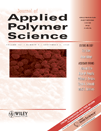Rheological properties of PDMS filled with CaCo3: The effect of filler particle size and concentration
Abstract
The effects of filler particle size and concentration on the rheological properties of hydroxyl terminated polydimethylsiloxane (HO-PDMS) filled with calcium carbonate (CaCO3) were investigated by an advanced rheometric expansion system (ARES). The Casson model was used to describe the relationship between shear stress and shear rate for steady-state measurement. Micron-CaCO3 could not afford the CaCO3/HO-PDMS suspensions obvious shear thinning behavior and a yield stress high enough, whereas nano-CaCO3 could provide the suspensions with remarkable shear thinning behavior and high yield stress. Incorporation of nano-CaCO3 into HO-PDMS resulted in the transformation of HO-PDMS from a mainly viscous material to a mainly elastic material. With increasing nano-CaCO3 content, shear thinning behavior of nano-CaCO3/HO-PDMS suspensions became more obvious. Remarkable yield stress was observed in nano-CaCO3/HO-PDMS suspensions with high filler content, and increased with increasing nano-CaCO3 content. The degree of thixotropy was quantitatively determined using a thixotropic loop method. It was found that nano-CaCO3 favored more the buildup of filler network structure in the suspensions than micron-CaCO3 at the same weight fraction. Furthermore, increasing nano-CaCO3 content accelerated the establishment of filler network structure in the nano-CaCO3/HO-PDMS suspensions. An overshoot phenomenon was observed in the nano-CaCO3/HO-PDMS suspensions at high shear rates. © 2006 Wiley Periodicals, Inc. J Appl Polym Sci 101: 3395–3401, 2006




